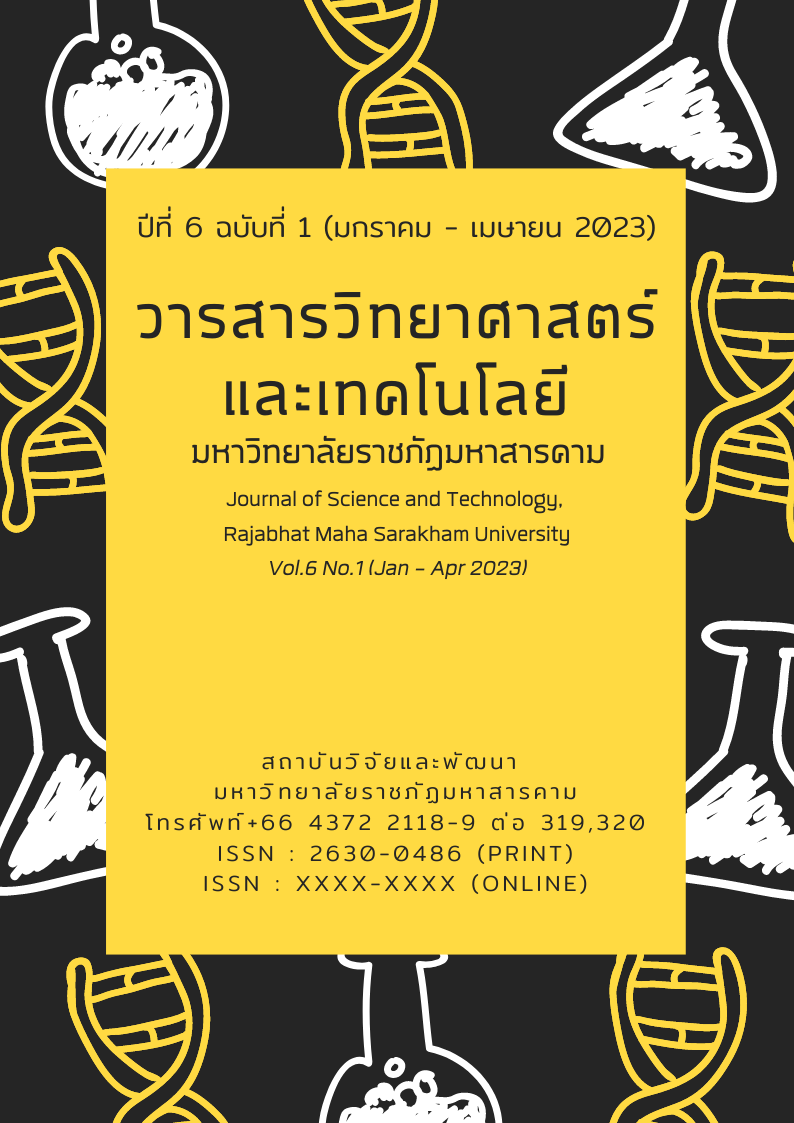Improvement of Optimal Reservoir Rule Curve by Atom Search Technique: A Case Study of Huai Luang Reservoir
Keywords:
Reservoir rule curve, Optimization techniques, Atom Search Optimization, Reservoir ManagementAbstract
The objective of this study was to investigate the best optimization of the reservoir rule curve by applying the atomic search optimization technique together with the simulation of the Huai Luang reservoir system, Udon Thani Province. In three cases, objective functions are utilized in the search for the optimal solution: the mean of the least water shortages, the least frequency of water shortages, and the smallest maximal shortage. The monthly data for the reservoir rule curve were considered. The data used in this study consisted of monthly average runoff into the reservoir from 1984-2022, hydrologic data, water demand information, and reservoir physical data. The results show that the new rule curve obtained using the Atom Search Optimization technique has a similar shape to the existing rule curve. When the new rule curve was tested and compared to the existing rule curve under identical conditions, the new rule curve was found to be more accurate. It was determined that the new rule curve mitigates water shortage and excess conditions more effectively than the existing rule curve. In addition, 1,000 sets of monthly runoff events were synthesized for the reservoir to evaluate the efficiency of the new rule curve. It was found to perform slightly better than the existing rule curve.
References
Almagboul, M. A., Shu, F., Qian, Y., Zhou, X., Wang, J., & Hu, J. (2019). Atom search optimization algorithm based hybrid antenna array receive beamforming to control sidelobe level and steering the null. AEU-International Journal of Electronics and Communications, 111, 152854.
Barshandeh, S., & Haghzadeh, M. (2021). A new hybrid chaotic atom search optimization based on tree-seed algorithm and Levy flight for solving optimization problems. Engineering with Computers, 37(4), 3079-3122.
Bhumiphan, N. (2021). Improvement of Optimal Reservoir Operation Rule Curve by Tabu Search: A Case Study of Huai Luang. Journal of King Mongkut's University of Technology North Bangkok, 31(3), 461-470.
Chang, F. J., Chen, L., & Chang, L. C. (2005). Optimizing the reservoir operating rule curves by genetic algorithms. Hydrological Processes: An International Journal, 19(11), 2277-2289.
Choi, Y., Lee, E., Ji, J., Ahn, J., Kim, T., & Yi, J. (2020). Development and evaluation of the hydropower reservoir rule curve for a sustainable water supply. Sustainability, 12(22), 9641.
Deb, D., Tuppad, P., Daggupati, P., Srinivasan, R., & Varma, D. (2015). Spatio-temporal impacts of biofuel production and climate variability on water quantity and quality in upper Mississippi River basin. Water, 7(7), 3283-3305.
Fayaed, S. S., Fiyadh, S. S., Khai, W. J., Ahmed, A. N., Afan, H. A., Ibrahim, R. K., . . . Binti Jaafar, W. Z. (2019). Improving dam and reservoir operation rules using stochastic dynamic programming and artificial neural network integration model. Sustainability, 11(19), 5367.
Jonoski, A., & Popescu, I. (2012). Distance learning in support of water resources management: an online course on decision support systems in river basin management. Water Resources Management, 26(5), 1287-1305.
Kangrang, A., & Lokham, C. (2013). Optimal Reservoir Rule Curves Considering Conditional Ant Colony Optimization with. Journal of applied sciences, 13(1), 154-160.
Kumar, D. N., & Baliarsingh, F. (2003). Folded dynamic programming for optimal operation of multireservoir system. Water Resources Management, 17(5), 337-353.
Marchand, A., Gendreau, M., Blais, M., & Guidi, J. (2019). Optimized operating rules for short-term hydropower planning in a stochastic environment. Computational Management Science, 16(3), 501-519.
Ngene, B. U., Nwafor, C. O., Bamigboye, G. O., Ogbiye, A. S., Ogundare, J. O., & Akpan, V. E. (2021). Assessment of water resources development and exploitation in Nigeria: A review of integrated water resources management approach. Heliyon, 7(1), e05955.
Plermkamon, V. (1993). Runoff Generation by HEC-4. Engineering and Applied Science Research, 20(1), 31-37.
Rattana, H., Anongrit, K., Alongkorn, L., Chavalit, C., & Sanguan, P. (2012). Coupled-operations model and a conditional differential evolution algorithm for improving reservoir management. International Journal of Physical Sciences, 7(42), 5701-5710.
Rodriguez, L. B., Cello, P. A., Vionnet, C. A., & Goodrich, D. (2008). Fully conservative coupling of HEC-RAS with MODFLOW to simulate stream–aquifer interactions in a drainage basin. Journal of Hydrology, 353(1-2), 129-142.
Saimuang, K., & Kangrang, A. (2017). Optimal water allocation criteria using the Tabu Search technique. Journal of Science and Technology Mahasarakham University, 36(1), 1-9.
Shaikh, S. A., & Pattanayek, T. (2022). Implicit stochastic optimization for deriving operating rules for a multi-purpose multi-reservoir system. Sustainable Water Resources Management, 8(5), 1-13.
Soundharajan, B.-S., Adeloye, A. J., & Remesan, R. (2016). Evaluating the variability in surface water reservoir planning characteristics during climate change impacts assessment. Journal of Hydrology, 538, 625-639.
Stedinger, J. R. (1984). The performance of LDR models for preliminary design and reservoir operation. Water Resources Research, 20(2), 215-224.
Vudhivanich, V., & Rittima, A. (2003). Development of Probability Based Rule Curves for a Reservoir. Agriculture and Natural Resources, 37(2), 234-242.
Wan, W., Guo, X., Lei, X., Jiang, Y., & Wang, H. (2018). A novel optimization method for multi-reservoir operation policy derivation in complex inter-basin water transfer system. Water Resources Management, 32(1), 31-51.
Water Resources and Environment Institute. (2015). Development Plan for the Lower Huai Luang Basin, Udon Thani and Nong Khai Provinces. Retrieved from https://home.kku.ac.th/wrei/index.php/work?showall=1&limitstart=
Xu, D., Lyon, S. W., Mao, J., Dai, H., & Jarsjö, J. (2020). Impacts of multi-purpose reservoir construction, land-use change and climate change on runoff characteristics in the Poyang Lake basin, China. Journal of Hydrology: Regional Studies, 29, 100694.
Yang, X.-S., & Deb, S. (2009). Cuckoo search via Lévy flights. Paper presented at the 2009 World congress on nature & biologically inspired computing (NaBIC).
Zhao, W., Wang, L., & Zhang, Z. (2019). Atom search optimization and its application to solve a hydrogeologic parameter estimation problem. Knowledge-Based Systems, 163, 283-304.



